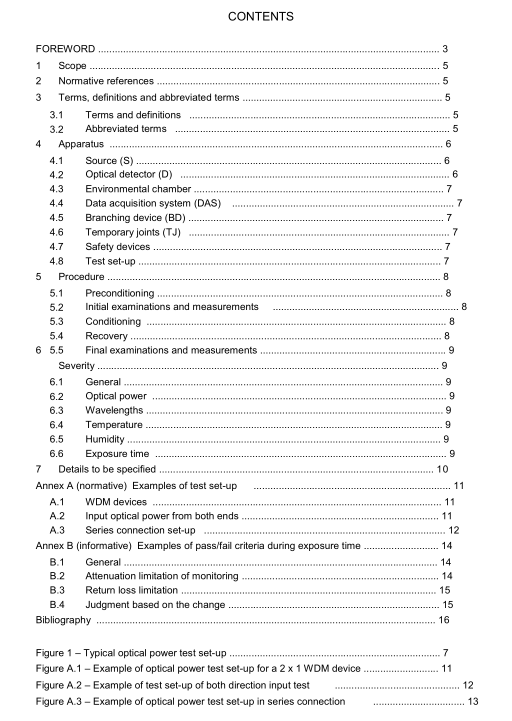IEC 61300-2-14 pdf – Fibre optic interconnecting devices and passive components – Basic test and measurement procedures – Part 2-14: Tests – High optical power

IEC 61300-2-14 pdf – Fibre optic interconnecting devices and passive components – Basic test and measurement procedures – Part 2-14: Tests – High optical power
For multiport devices such as branching devices, all combinations of input and output ports shall be tested, unless otherwise stated in the relevant specification. For WDM devices, multiple wavelengths shall be input at the same time according to the application. Clause A.1 describes an example of the test set-up for WDM devices. To minimize test equipment, the DUTs may be connected in series. Clause A.2 describes an example of the test set-up for series-connected DUTs.
5 Procedure
5.1 Preconditioning The chosen test samples shall be representative of a standard product. Prepare and clean the DUTs according to the manufacturer’s instructions. Visual examination shall be undertaken in accordance with IEC 61300-3-1 and IEC 61300-3-35. Debris or the presence of contamination is one of the primary causes of failure in high optical power connector applications. NOTE IEC TR 62627-01 describes fibre optic connector cleaning methods. Precondition the DUTs for 2 h or more at the standard atmospheric conditions as defined in IEC 61300-1, unless otherwise specified in the relevant specification. 5.2 Initial examinations and measurements Perform initial examinations and measurements on the DUTs as required by the relevant specification. The results of the initial measurements shall be within the limits established in the relevant specification.
5.3 Conditioning
a) Set the chamber and the DUT to the standard atmospheric conditions. Place the DUT in the chamber in its normal operating position. The hook-ups of the DUT to the peripheral equipment shall also be placed in their normal operating position, where required. b) Set the chamber temperature and humidity to the specified severities (see 6.4 and 6.5). The rate of change of temperature shall not exceed 1 °C/min, averaged over a maximum period of 5 min. Allow the DUT to reach the set stable temperature and maintain the temperature for the exposure time.
c) Set the wavelength and optical power to be input to the DUT and turn on the optical source and input optical power to the DUT.
d) Continue to input the optical power to the DUT for the exposure time specified (see 6.6). Monitor the changes in attenuation and return loss of the DUT according to IEC 61300-3-3 during the exposure time. The changes shall be within the pass criteria specified in the relevant specification (see Annexe B). NOTE Optical power absorption within the DUT can cause its internal temperature to rise leading to a change in attenuation. The duration of changing attenuation depends on the absorption rate and the thermal capacity of the DUT. Examples of the high power test results are described in IEC TR 62627-03-02 and IEC TR 62627-03- 03.
e) At the completion of the exposure time, stop inputting the optical power and change the temperature in the chamber to the standard atmospheric condition. Continue to maintain the DUT in the chamber while the temperature is gradually changed.
5.4 Recovery Allow the DUT to remain under the standard atmospheric condition for 2 h or more, as defined in IEC 61300-1, unless otherwise specified in the relevant specification.
5.5 Final examinations and measurements On completion of the test, remove all fixtures and make final examinations and measurements on the DUT, as required by the relevant specification, to ensure that there is no permanent damage to the DUT. Clean the DUT according to the manufacturer’s instructions. The results of the final measurement shall be within the limit established in the relevant specification. Unless otherwise specified in the relevant specification, visually examine the DUT in accordance with IEC 61300-3-1. Check for evidence of any degradation in the DUT. These include, for example:
a) broken, loose or damaged parts or accessories;
b) breaking or damage to the cable jacket, seals, strain relief or fibres;
c) displaced, bent, or broken parts.
6 Severity General
6.1 Severity is a combination of an optical power, a wavelength, a temperature, humidity and an exposure time. The severity shall be specified in the relevant specification. NOTE IEC TR 62627-03-04 gives guidelines for high optical power testing.
6.2 Optical power The optical power of the test shall be decided in consideration of the application, unless otherwise stated in the relevant specification. The recommended power levels for testing are: 10 mW, 30 mW, 50 mW, 100 mW, 300 mW and 500 mW.
6.3 Wavelengths The test wavelength shall be the centre or typical wavelength of all operating wavelength ranges specified in the relevant specification. The recommended wavelengths for testing are: 980 nm, 1 310 nm, 1 490 nm, 1 510 nm, 1 550 nm, 1 580 nm, 1 610 nm, 1 625 nm and 1 650 nm. For WDM devices, the combinations of multi-wavelengths which are input at the same time shall be decided in consideration of the application, unless otherwise stated in the relevant specification.
6.4 Temperature Unless otherwise stated in the relevant specification, the test temperature shall be the maximum temperature of the operating temperature range specified in the relevant specification.









